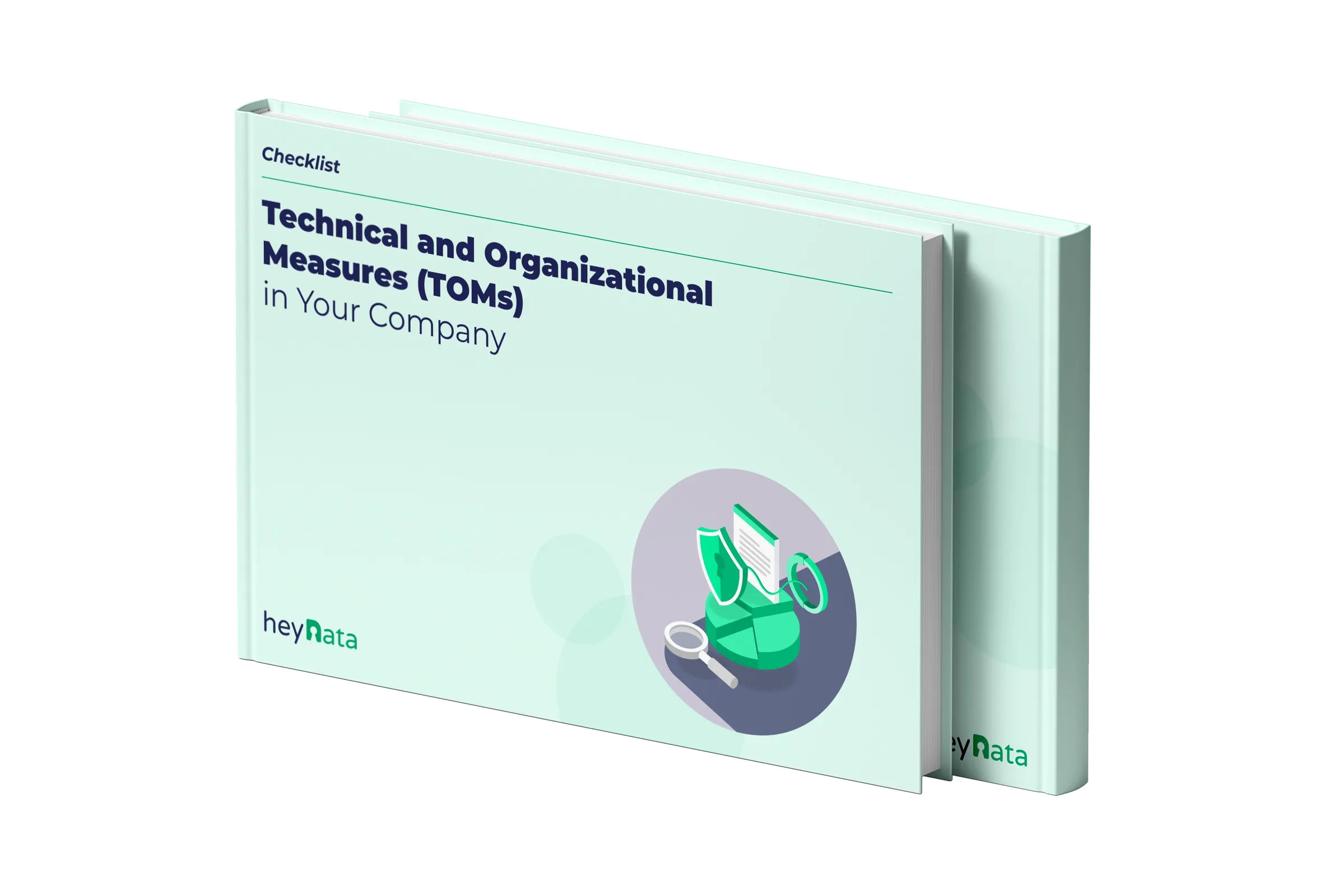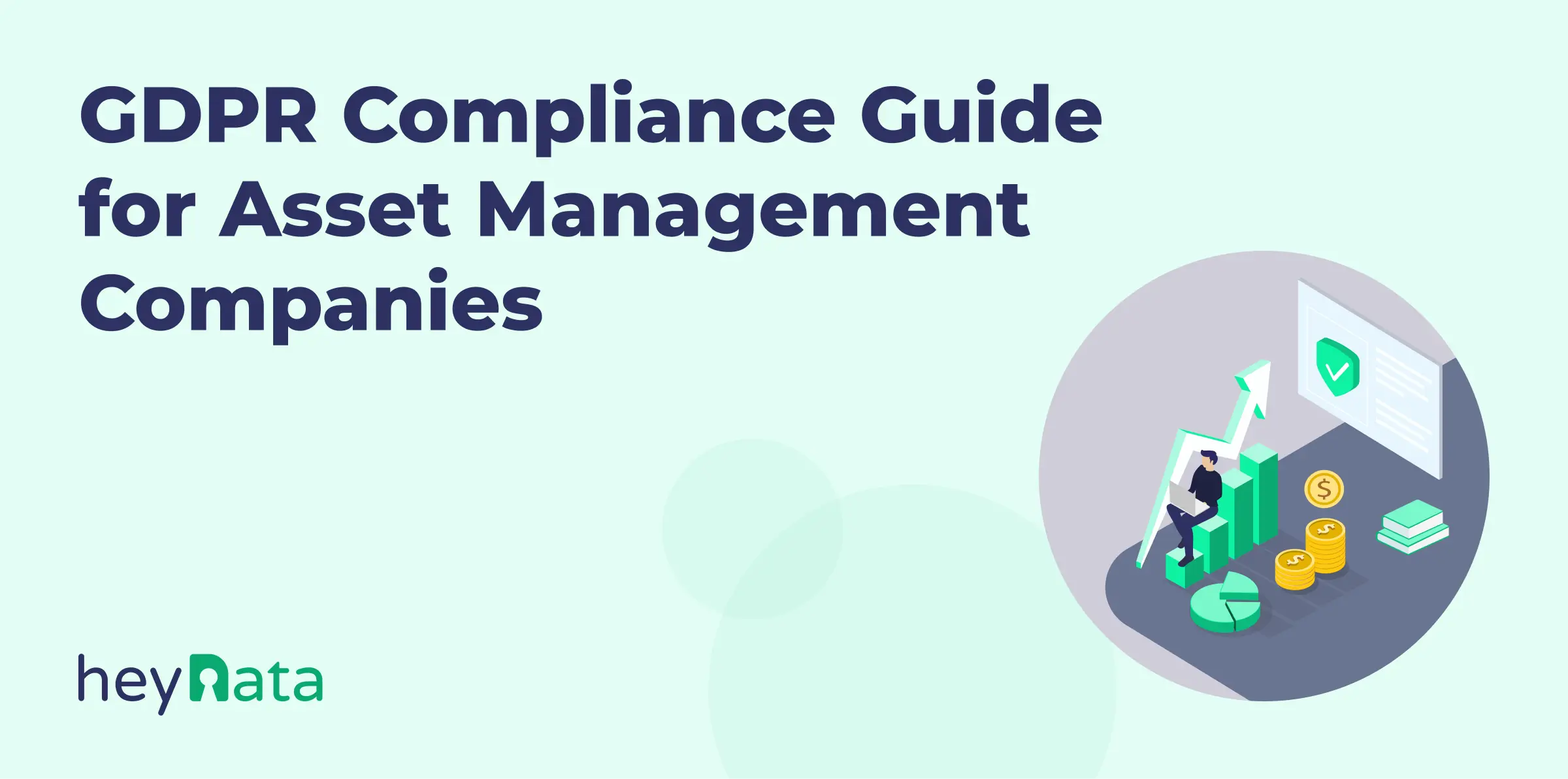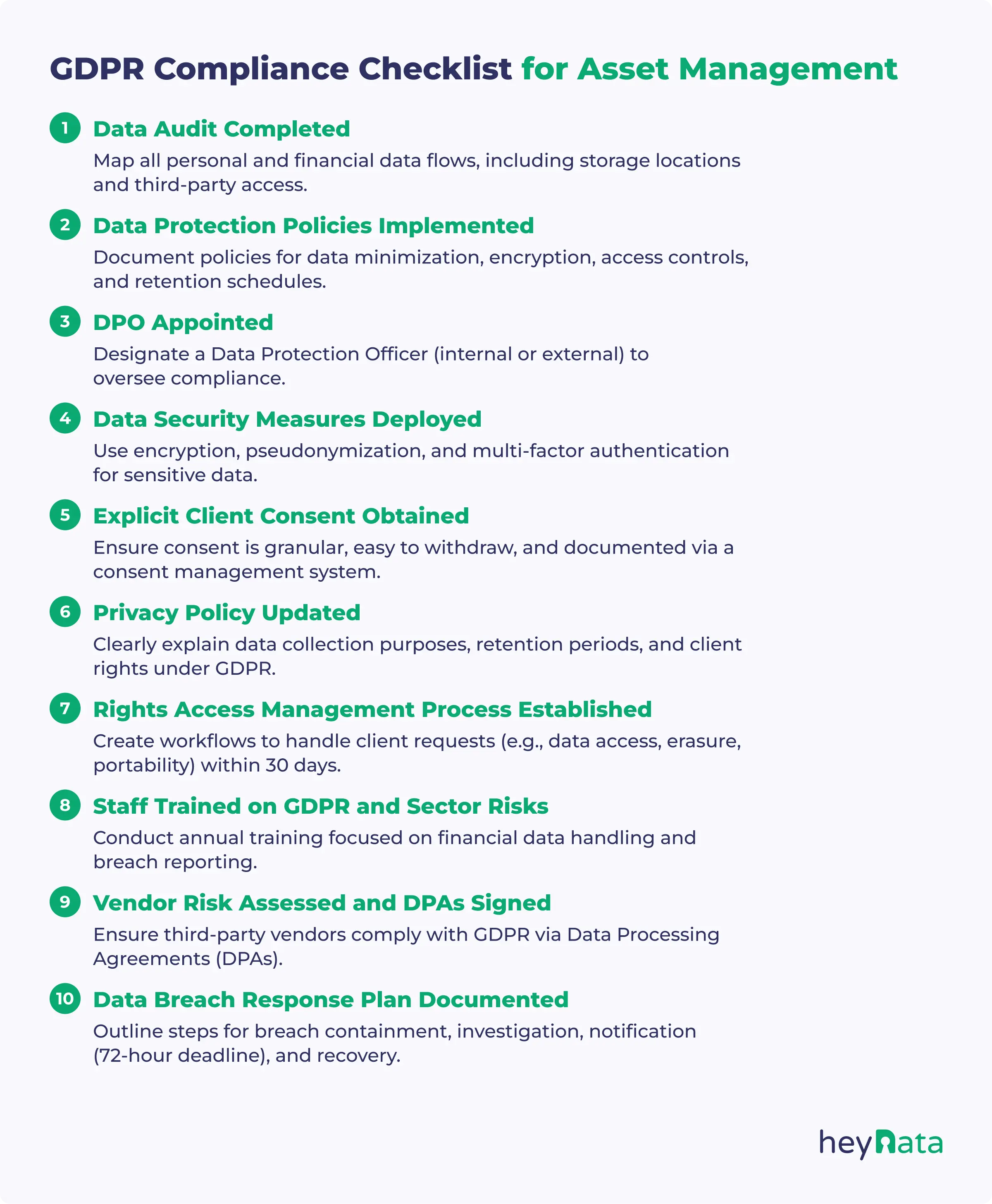
TOMs Checklist for Businesses
Get our practical checklist for Technical and Organisational Measures (TOMs) to ensure GDPR compliance.

GDPR Compliance Guide for Asset Management Companies

'%3e%3cpath%20d='M26.6667%2020.022L30%2023.3553V26.6886H21.6667V36.6886L20%2038.3553L18.3333%2036.6886V26.6886H10V23.3553L13.3333%2020.022V8.35531H11.6667V5.02197H28.3333V8.35531H26.6667V20.022Z'%20fill='%230AA971'/%3e%3c/g%3e%3c/svg%3e) Summary
Summary
- GDPR compliance is critical for asset management firms due to the volume and sensitivity of financial and personal data they process.
- A thorough data audit is the foundation for identifying and protecting all types of client information.
- Strong internal data protection policies, explicit client consent, and regular staff training are essential.
- Vendor and third-party risk management is necessary, as firms remain responsible for breaches involving external partners.
- Firms must have a documented data breach response plan and notify authorities within 72 hours if a breach occurs.
- Compliance is not just about avoiding fines but also about maintaining client trust and industry reputation
Asset management companies handle vast amounts of sensitive financial data, including client portfolios, detailed transaction histories, and personalized investment strategies.
As custodians of this highly sensitive information, asset management firms are uniquely positioned in the data protection landscape, facing both significant regulatory oversight and the high expectations of their clients.
As such, General Data Protection Regulation (GDPR) compliance is, therefore, not only a legal imperative but also a crucial element of maintaining client trust and protecting the reputation of your company. Non-compliance with GDPR can lead to fines, reputational damage, and loss of client confidence, highlighting the need for strong data governance practices.
Asset management intersects with sector-specific regulations such as MiFID II in the EU and Dodd-Frank in the US, adding layers of complexity to data protection obligations.
In this guide, we'll outline an actionable plan specifically designed for asset managers dealing with sensitive financial and personal data.
Table of Contents:
Step 1: Conduct a Data Audit
Conducting a comprehensive data audit is the first step toward achieving GDPR compliance for asset management firms.
Given the complexity and sensitivity of the financial data these firms handle, it’s crucial to clearly understand exactly what data is collected, where it's stored, how it flows within and outside the organization, and how it's being used.
Asset management companies typically deal with various types of personal and financial information, which includes:
- Client onboarding information, such as identification details, contact information, financial background, and risk tolerance questionnaires.
- Portfolio data, including asset allocations, transaction histories, investment holdings, and performance metrics.
- Sensitive financial insights, such as detailed analyses of client investment behaviors, trading activities, and market predictions.
The data audit process involves identifying all categories of personal data and financial information collected, stored, and processed. To conduct a data audit, follow these 5 steps:
- Identify Data Types and Sources: Document personal and financial data collected (e.g., client onboarding, portfolio details, transaction histories, risk profiles).
- Document Internal Data Flows: Map how data moves internally - from collection and analysis to archival or deletion, involving key departments like IT, Compliance, and Portfolio Management.
- Review External Data Sharing: Identify all data transfers to third parties such as brokers, custodians, analytics providers, ensuring GDPR-compliant agreements are in place.
- Inventory Storage and Processing Locations: Record all data storage solutions (cloud services, servers, physical records) and verify GDPR compliance for security, access control, and encryption.
- Prioritize Sensitive Financial Data: Give extra attention and protection to high-risk financial information (investment strategies, risk assessments, trading data).
With these 5 steps, you can map out the entire lifecycle of client data within your company. For assistance with performing a thorough, GDPR-compliant audit tailored to asset management, explore heyDatas specialized Data Protection Audit Services.
Step 2: Implement Strong Data Protection Policies
Once a thorough data audit has been completed, the next critical step is to use those findings to design and implement strong, GDPR-compliant data protection policies.
While the audit reveals how data currently flows through your company, this step is about shaping and controlling that flow through clear internal rules and procedures.
These policies should comprehensively address the full data lifecycle, covering:
- Data collection: Define what personal and financial data is collected, why it is necessary, and the lawful basis for collecting it.
- Data processing: Outline how data is used within the organization, who has access, and how processing activities are monitored for compliance.
- Data retention: Set rules for how long different categories of data are retained, in line with both GDPR and financial industry regulations.
- Data sharing: Establish procedures for securely sharing data with third parties, including brokers, custodians, and regulatory bodies.
In addition to general data management, policies must address the handling of particularly sensitive data such as investment strategies, portfolio allocations, and financial assessments. This includes implementing stricter access controls, encryption standards, and protocols for internal sharing.
Finally, strong policies must reinforce GDPR principles, particularly:
- Data minimization: Collect only the data that is strictly necessary for operational and regulatory purposes.
- Purpose limitation: Use data solely for the purposes initially specified.
- Access control: Limit access to sensitive data to only those employees who need it for their roles.
For asset management firms, well-structured data protection policies do more than meet legal requirements. They also help mitigate risks unique to the industry, such as insider trading, market manipulation, or unauthorized disclosure of confidential investment data.

TOMs Checklist for Businesses
Get our practical checklist for Technical and Organisational Measures (TOMs) to ensure GDPR compliance.
Step 3: Appoint a Data Protection Officer (DPO)
Appointing a Data Protection Officer (DPO) is a key requirement under the GDPR for organizations that process large volumes of sensitive personal data, which is the case for most asset management firms.
The DPO plays a central role in ensuring the company meets its legal obligations, protects client data, and builds a culture of privacy across departments. The DPO is responsible for overseeing data protection strategies and ensuring they align with GDPR principles. Their duties include:
- Monitoring compliance
- Conducting regular audits
- Advising on data protection impact assessments
- Acting as the contact point for data subjects and supervisory authorities
To be effective, the DPO must operate independently, with the authority to enforce policies and the autonomy to report directly to senior management. This direct reporting line helps avoid conflicts of interest and ensures that data protection remains a strategic priority at the executive level.
In an asset management firm, the DPO also needs to collaborate closely with both the compliance and IT departments. Compliance teams align data policies with financial regulations such as MiFID II or Dodd-Frank. With IT, they work on securing digital infrastructure and managing risks related to data breaches or system vulnerabilities.
Given the dual responsibility of safeguarding data and adhering to stringent financial regulations, the ideal DPO in this industry must possess a strong understanding of both GDPR and the regulatory landscape specific to financial services.
However, many companies, especially small to mid-sized firms, may lack the resources or internal expertise to appoint a full-time, in-house DPO. In such cases, partnering with an external DPO can be a highly effective solution. External DPOs bring specialized knowledge, an objective perspective, and cost-efficiency, helping firms meet regulatory obligations without overextending internal resources.
If your firm is considering this approach, you can learn more about heyDatas external DPO Services to see how they support GDPR compliance in the asset management sector.
Step 4: Ensure Data Security
For asset management firms, maintaining data security is a critical layer of operational resilience in a sector where the stakes are exceptionally high. A single breach can lead to significant financial loss, legal penalties, and long-term damage to client trust.
To protect this data, asset management companies must implement a strong set of technical and organizational measures, including:
- Encryption of all sensitive data, both in transit and at rest, to prevent unauthorized access even if data is intercepted or stolen.
- Secure storage solutions with redundancy and backup protocols to ensure data integrity and availability.
- Multi-factor authentication (MFA) to strengthen access controls and prevent unauthorized logins.
- Role-based access control (RBAC) to ensure that only authorized personnel can view or handle confidential financial information.
Additionally, secure communication channels must be used when sharing sensitive data externally with brokers, custodians, or regulators. This may involve encrypted email systems, secure portals, or VPNs.
Security protocols should be routinely tested through vulnerability scans, penetration testing, and regular audits. These practices help detect weaknesses and fix them proactively before they can be exploited.
Step 5: Obtain Explicit Consent from Clients
Obtaining explicit, informed consent from clients is a core requirement under GDPR. Given the sensitive nature of the data involved, consent should be clear, specific, and fully documented.
In asset management, consent is often embedded into onboarding, but it must go beyond mere legal formality. Clear communication about data use, especially for portfolio management, reporting, or risk assessment, is key to both compliance and long-term client confidence.
You must ensure your clients clearly understand:
- What data is being collected, such as financial history, portfolio details, and investment goals.
- Why it’s being collected, whether for regulatory compliance, risk profiling, or personalized investment strategies.
- How the data will be used, including internal analysis, reporting, or sharing with third parties like custodians or analytics providers.
Equally important, clients must be given a simple and accessible way to withdraw consent at any time, without penalties or complicated procedures. To streamline this process and ensure ongoing compliance, firms should consider implementing a consent management system, such as CookieYes, UserCentrics or consentmanager . These systems make it easy to track, update, and revoke consent while maintaining proper documentation, providing both transparency for clients and legal protection for the firm.
Step 6: Review and Update Privacy Policy
A clear, up-to-date privacy policy is essential for GDPR compliance and client trust.
The policy should explain how client data is collected, processed, stored, and shared, and it must be written in plain, accessible language.
It should also inform clients of their rights under GDPR, such as the right to access, correct, or delete their data, including how they can exercise those rights.
Regular reviews are vital to ensure the policy reflects any changes in data practices, legal obligations, or new regulatory guidance relevant to financial services.
Step 7: Rights Access Management
As established in the Privacy Policy section, clients have the right to access, correct, and in some cases erase their personal data.
As such, your asset management company must have clear, user-friendly processes in place to honor these rights efficiently and transparently.
You should establish internal workflows for handling data subject requests, ensuring that responses are provided within the legally required 30-day period. These processes should be well-documented and accessible to both clients and relevant staff.
At the same time, asset managers must strike a careful balance between client rights and regulatory obligations. Certain types of financial data, such as transaction histories or portfolio records, must often be retained for compliance with financial regulations. Policies should reflect this and explain clearly when and why data may be exempt from erasure.
Giving clients control over their data while maintaining legal compliance demonstrates your company's commitment to responsible data governance in this highly regulated industry.
Step 8: Staff Training and Awareness
Employees play a central role in GDPR compliance, and regular training is essential to ensure they’re equipped to handle sensitive financial data responsibly.
From client-facing advisors to compliance officers and IT staff, every team member must understand how their actions impact data security and regulatory risk.
Training should cover the fundamentals of GDPR, internal data protection policies, and how to respond to client data requests such as access, correction, or erasure. It should also highlight the serious consequences of non-compliance, including legal penalties and reputational damage.
In the asset management industry, where financial data is both valuable and sensitive, tailored training should also address sector-specific risks like insider trading and confidentiality breaches.
To keep your team up to date and compliant, consider implementing structured, ongoing education. A dedicated platform like heydata’s compliance training program can help ensure that your staff remain informed, alert, and ready to meet both GDPR and financial regulatory requirements.
Step 9: Manage Vendor and Third-Party Risk
GDPR compliance doesn’t stop at internal processes. Vendor Risk Management is especially important in asset management, where third parties often access sensitive and market-relevant financial information.
It's important to highlight that even if the data breach occurs on a vendor’s side, your firm may still be held accountable.
This extends to every external partner that handles client data.
To manage third-party risk, start by identifying all third-party vendors involved in processing client data. These may include trading platforms, custodians, fund administrators, analytics providers, and even cloud storage services.
Once identified, ensure that Data Processing Agreements (DPAs) are in place with each vendor. These agreements should clearly outline the vendor’s responsibilities for securing personal data and adhering to GDPR standards.
Beyond contracts, you must also assess each vendor’s data protection practices, including encryption standards, breach response protocols, and access controls. Due diligence should be performed during onboarding and revisited regularly through audits or assessments to verify ongoing compliance.
To simplify and strengthen this process, consider using a structured solution for monitoring third-party risks, such as heydata’s Vendor Risk Management, which helps you quickly and reliably check all services and providers used for compliance with the GDPR.
Vendor Risk Management is critical in asset management, where third parties often access sensitive and market-relevant financial information.
Step 10: Prepare a Data Breach Response Plan
Establishing a data breach response plan is the final step in your GDPR compliance journey. It will ensure your asset management company is prepared for worst-case scenarios. While prevention is key, being ready to respond effectively if a breach occurs is just as critical.
Your plan should define procedures for quickly identifying, containing, and assessing the breach.
Once a breach is confirmed, you must notify the relevant supervisory authority within 72 hours, as required by GDPR. If the breach poses a high risk to individual rights and freedoms, affected clients must also be informed without delay.
Internally, the plan should establish clear communication protocols to ensure key personnel, such as the Data Protection Officer, compliance team, legal counsel, and executive leadership, are informed immediately.
Every incident must be thoroughly documented, including the nature of the breach, systems affected, response actions taken, and follow-up steps. This documentation supports auditing, internal reviews, and continuous improvement.
For asset managers, where data is tightly connected to financial markets and client trust, a breach can have wide-reaching consequences. Closing your compliance efforts with a strong response plan ensures your firm is both legally compliant and operationally resilient.

Conclusion
Achieving GDPR compliance in the asset management industry is not a one-time task but an ongoing commitment. It requires regularly auditing your data practices, updating internal policies, and investing in continuous staff training to keep pace with evolving data protection laws and financial regulations.
In this highly regulated industry where trust is paramount, staying compliant protects more than just data. It also protects your firm’s reputation, client relationships, and long-term operational success.
By embedding data protection into everyday operations and staying responsive to new regulatory developments, you can ensure your company is not only compliant but also competitive in a data-driven market.
For a streamlined, all-in-one approach to managing your compliance responsibilities, explore our All-in-One Compliance Solution.
Frequently Asked Questions (FAQs)
What is the first step for GDPR compliance in asset management?
The first step is conducting a comprehensive data audit to identify the firm's personal and financial data collected, stored, and processed.
Is appointing a Data Protection Officer (DPO) mandatory for asset managers?
Yes, asset management firms that process large volumes of sensitive personal data are generally required to appoint a DPO, either internally or externally.
How should asset managers handle client consent under GDPR?
Consent must be explicit, informed, and documented. Clients should be told what data is collected, why, and how it will be used, with an easy way to withdraw consent.
What happens if a third-party vendor causes a data breach?
The asset management firm may still be held accountable under GDPR, making vendor risk management and Data Processing Agreements (DPAs) essential.
How quickly must a data breach be reported?
A confirmed data breach must be reported to the relevant supervisory authority within 72 hours
Important: The content of this article is for informational purposes only and does not constitute legal advice. The information provided here is no substitute for personalized legal advice from a data protection officer or an attorney. We do not guarantee that the information provided is up to date, complete, or accurate. Any actions taken on the basis of the information contained in this article are at your own risk. We recommend that you always consult a data protection officer or an attorney with any legal questions or problems.


